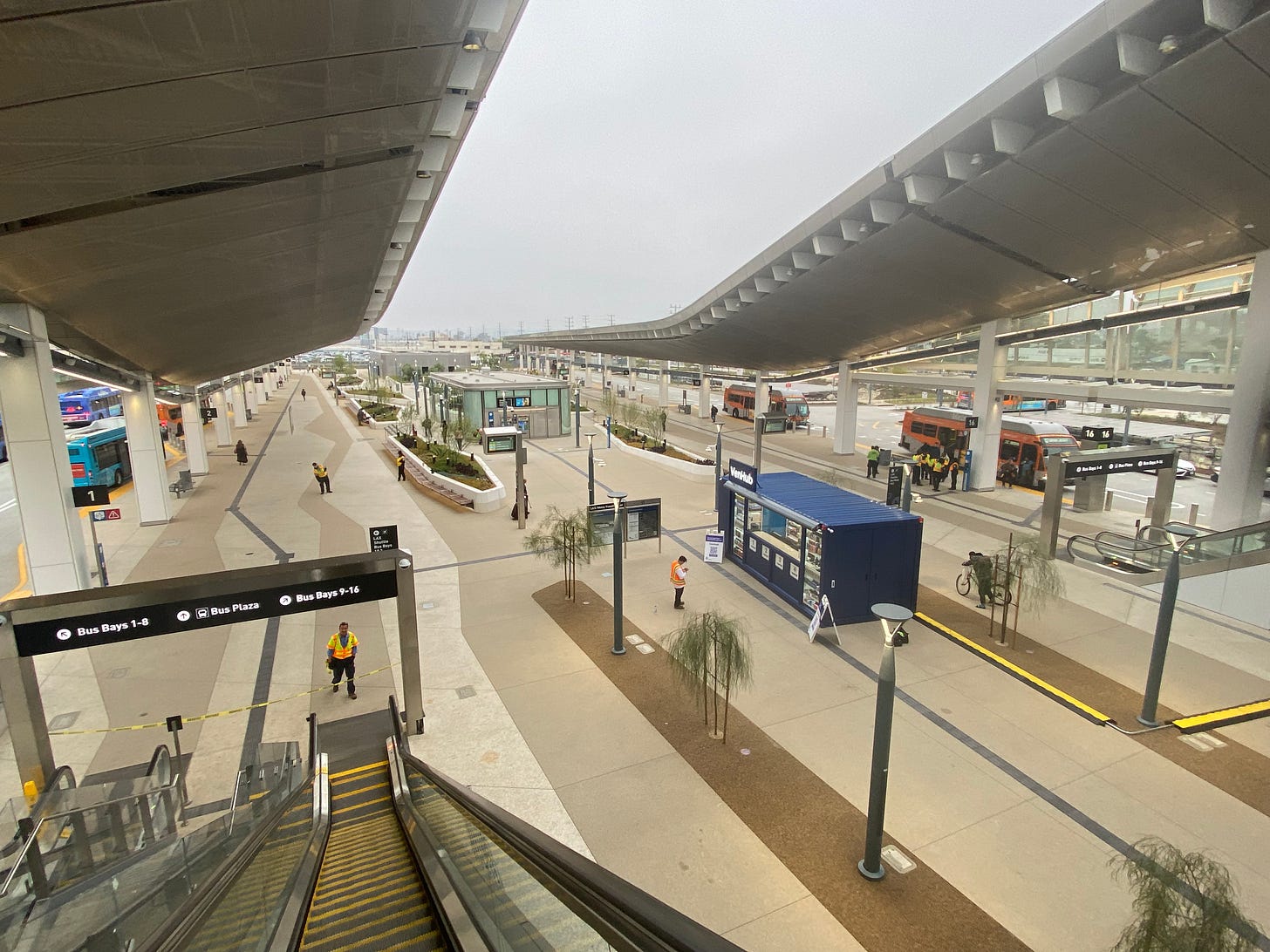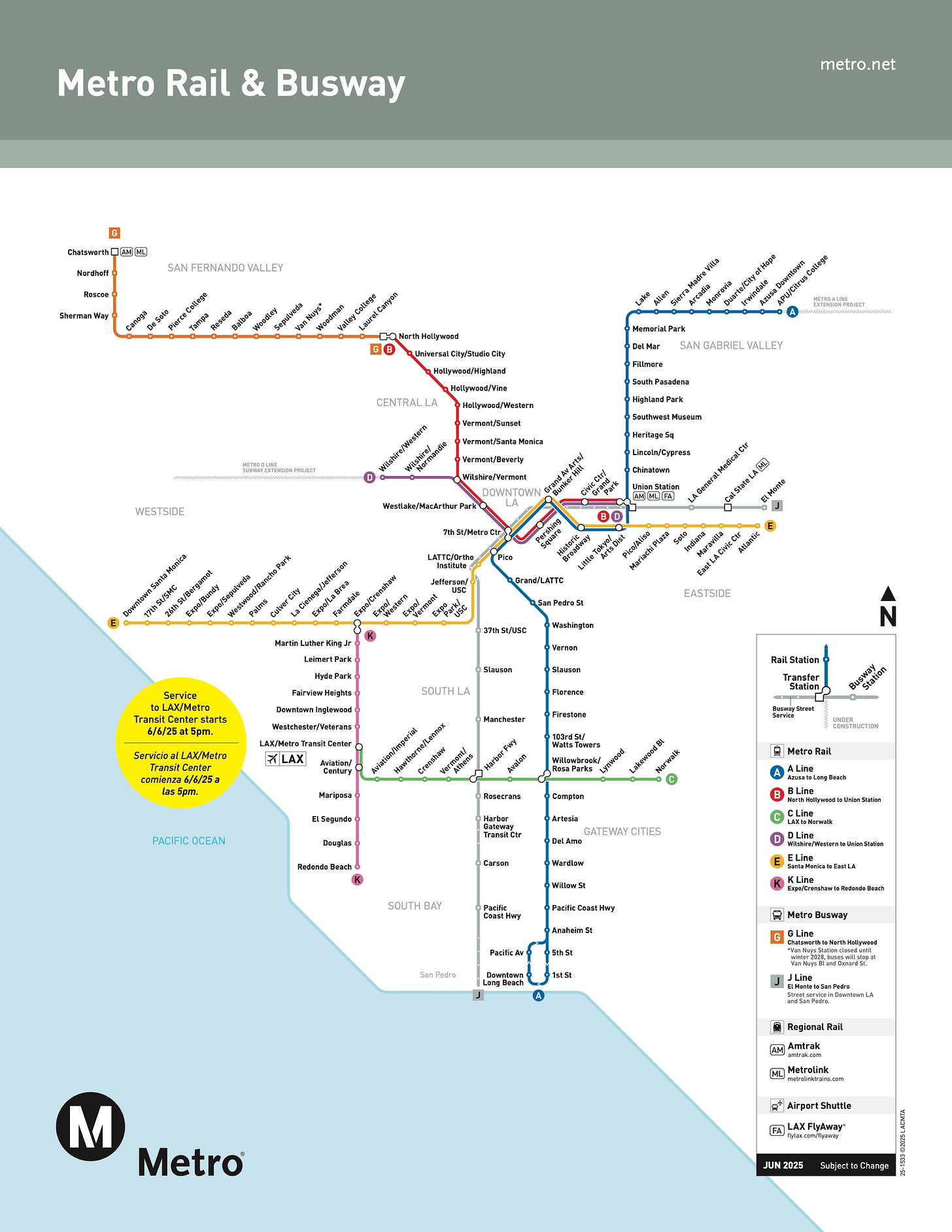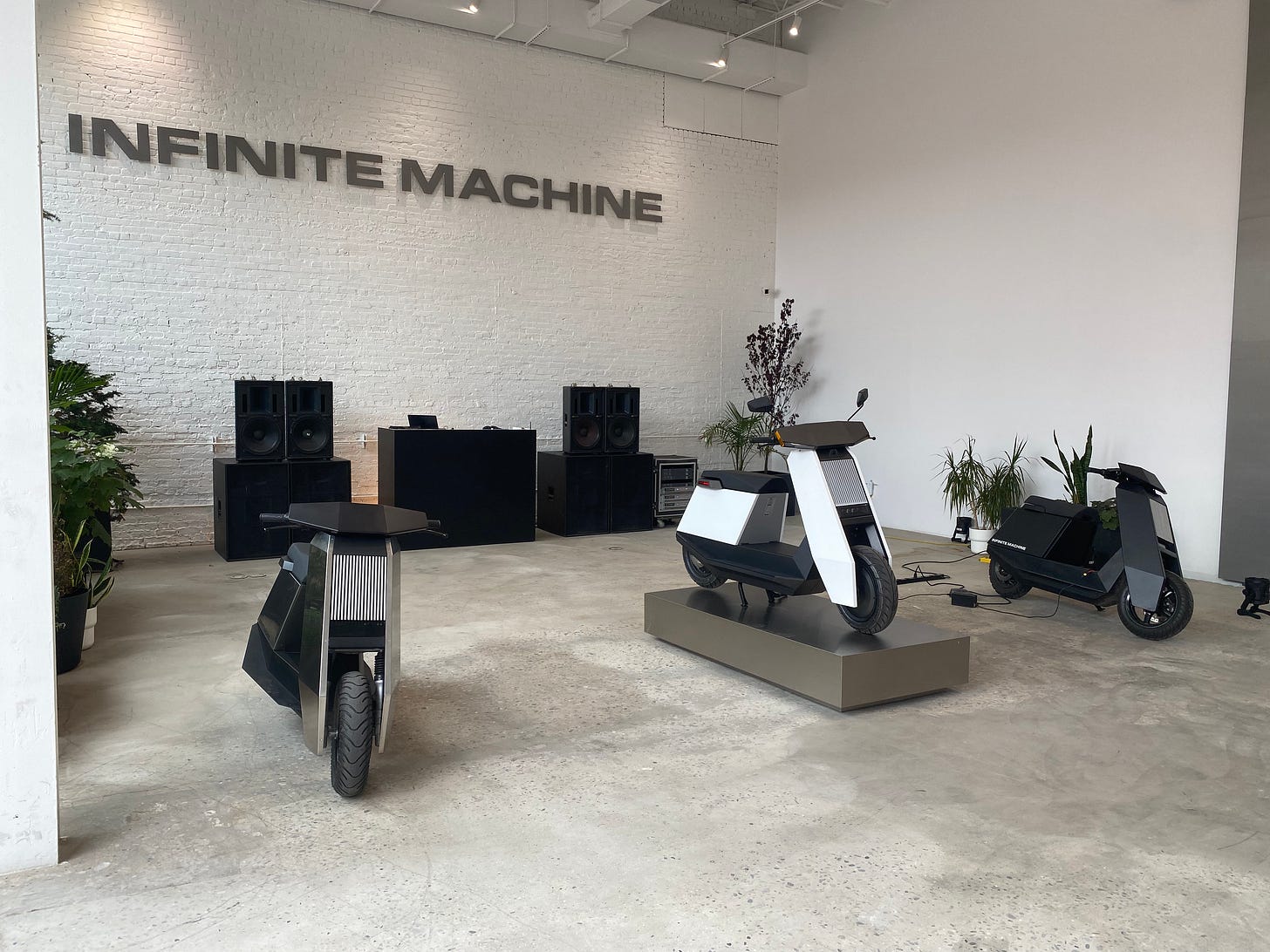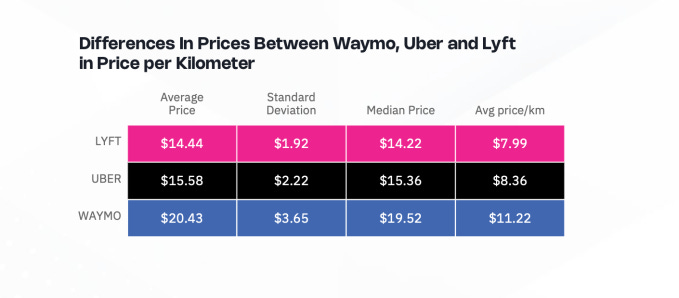A Polycentric Metro for The Polycentric City
Infinite Machine's new Olto, Obvio raises $22M
Earlier this week, I did something new as an Angeleno: I took the train to the airport. That’s right, with the completion of LACMTA’s new LAX/Metro Transit Center, the long-gestating plan to serve the nation’s busiest airport for origins and destinations has finally come to fruition. And while the intra-airport people mover doesn’t open for another year, the rapid transit link is already way faster than driving or Ubering through LAX’s notorious horseshoe during rush hour, let alone on a big travel holiday.
The station itself is beautiful, eye-catching to a degree that exceeds other recent Metro stations around the region. And the scale is monumental. One could quibble that they could have saved a few bucks and scaled back the station size, but after seeing it in person I think there’s value to the fact that this piece of infrastructure will be the first part of Los Angeles, or even the first part of America, that many travelers will see when they disembark from their long plane ride. First impressions count!
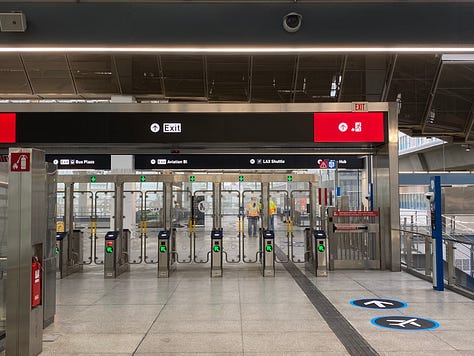
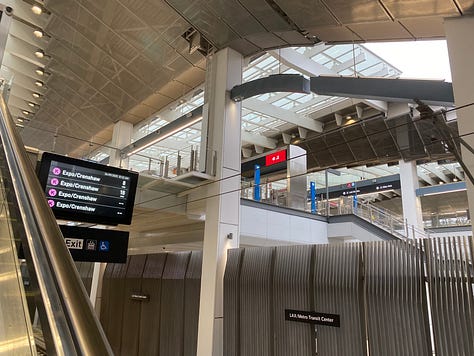
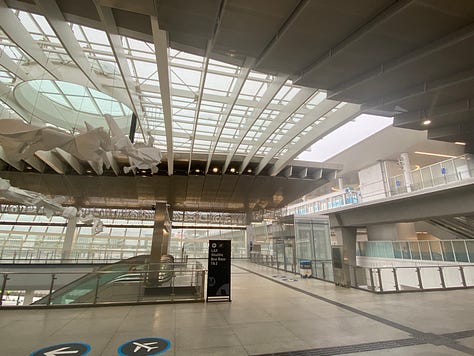
It’s Not the Station, It’s the Network
More impressive than the building itself is a detail that might seem arcane at first. This station serves as the connection between the K Line (first opened in 2022) and the C Line (opened way back in 1995.) Neither of those lines serves Downtown LA: the former plies a route spanning Inglewood, Leimert Park, West Adams and a planned extension to Mid-Wilshire and Hollywood; the latter connects Southeast LA with aerospace jobs in the Beach Cities.
Rapid transit lines that don’t serve a region’s primary downtown are rather rare in the United States. There are a few noteworthy examples — NYC’s infamous G train, BART’s Orange Line — but they’re generally bypasses that skirt the core while reusing CBD-bound infrastructure.
Los Angeles’ new C and K Line interchange is the first time that two routes that don’t serve downtown connect, anywhere in this country.
Los Angeles is of course famously polycentric, a series of basins and valleys filled with medium density apartments, punctuated by numerous high-density job centers: Downtown LA, Santa Monica, Koreatown, Hollywood, Long Beach, Pasadena, Century City, and so on. And the fact that the Metro network now serves many of those centers well, without necessarily requiring a stop in Downtown, is why Greater LA has had one of the best post-Covid ridership recoveries of any major American city, so much so that LA now has the second-highest transit ridership of any region nationwide.
Expect this trend to continue as additional non-downtown bound transit lines are built: the Sepulveda Pass Transit Corridor, the G Line Extension, the Southeast Gateway Line, and more.
You can get Americans out of their cars when you give them another commute option that can get them where they’re going without sacrificing on speed. And once folks see they don’t need their cars for everything, a whole wider world of mobility options suddenly becomes appealing: shared micromobility, carsharing, robotaxis, biking, and more. And as is so often the case, for both better and worse, LA is living in the future.
HOT INDUSTRY NEWS & GOSSIP
An infinitely smaller machine: While in NYC, I stopped by the snazzy headquarters of Infinite Machine. They turned heads last year with the launch of their electric moped, and they’ve just launched a second product: a “bike lane vehicle.” Having test-ridden both two-wheelers, I can say they are absolute pleasures to drive.
Ad nauseam? Also in the Big Apple… DoorDash proudly announced that their advertising network hit a $1 billion run rate. They’re not resting on their laurels, with the acquisition of Symbiosys and the launch of new tools geared towards SMBs.
E-bike explosion, but not the good kind. You’ve heard all about those battery fires on cheap Chinese scooters and bikes (usually when they’re improperly charged.) Even when the damage is non-catastrophic, it can still impact local businesses, per this sign I peeped.
Happiest hour! And on my last brief jaunt to NYC note, thanks to everyone that made it out to our happy hour. It’s always great to meet so many lovely folks working to advance mobility and delivery.
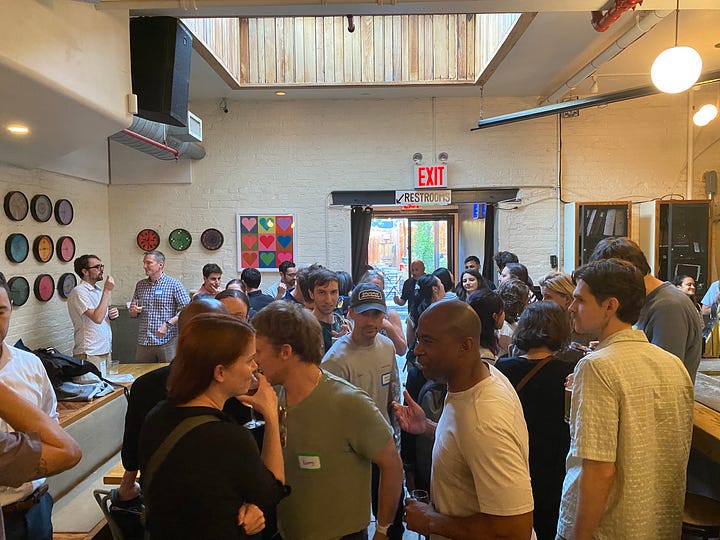
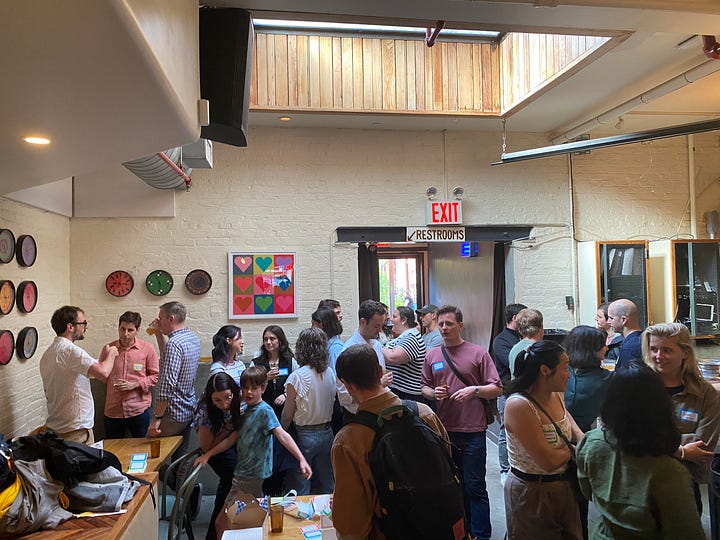
The camera see all: Obvio just raised $22 million for what seems like an obvious idea — the startup places cameras at stop signs, fines reckless drivers and then splits the revenue with cities. The image is stored locally and deleted after 24 hours, hopefully quelling some privacy concerns. Relatedly, Maryland just OKed the use of more anti-speeding cameras.
Have we learned nothing? SPACs are so back! Autonomous truck startup Plus is going public, raising $300M at a $1.2 billion valuation. Check out the fancy fundraising deck that conveniently does not mention just how little revenue the company has…
More money for friends of the curb! Robo-deliverer Coco just raised $80 million, with investors including Sam Altman, Max Altman, Pelion Venture Partners, Saltwater and Offline Ventures. And curb management startup Modii just closed on its seed round.
Is this the closest we’re going to get to an Apple Car? Also, the secretive mobility brand spun out of Rivian, is eventually expected to reveal its first sub-auto scale vehicle. Expect it to look real snazzy, as it’s reportedly been designed by famed ex-Apple designer Jony Ive.
Talk about double speak… The Transportation Research Board (TRB) is eliminating many of its research committees to “better reflect national priorities.” Do read the entire disheartening letter.
Waymo costs mo: New data suggests that Waymo rides in San Francisco cost more than the Uber or Lyft equivalent. Anecdotally, I would say that Waymo’s Jaguar is a much nicer vehicle than the car you’d get on an UberX or standard Lyft ride, so it might be more fair to compare these to each brand’s upmarket selection.
A few good links: Connecticut axes parking minimums. Maybe this is a sign that RFPs are too complicated — Altura raises €8M for AI-powered bid management platform. NYC declares war on e-bikes. Uber to pilot robotaxis with UK’s Wayve. The Washington Post looks at low-speed vehicles. Tesla robotaxis spotted in Austin. White House seeks to “unleash American drone dominance.” How Toronto’s Metrolinx expansion went off the tracks. Proposed transit funding changes. Memphis’ dire public transit situation looks to worsen.
Until next time!
- Jonah Bliss & The Curbivore Crew


